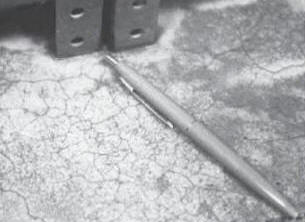

CIP #3- Crazing Concrete Surfaces
WHAT is Crazing?

Crazing is the development of a network of fine random cracks or fissures on the surface of concrete or mortar caused by shrinkage of the surface layer. These cracks are rarely more than ⅛ inch [3 mm] deep and are more noticeable on steel-troweled surfaces. The irregular hexagonal areas enclosed by the cracks are typically no more than 1˝ inches [40 mm] across and may be as small as ˝ or ⅜ inch [12 or 20 mm] in unusual instances. Generally, craze cracks develop at an early age and are apparent the day after placement or at least by the end of the first week. Often they are not readily visible until the surface has been wetted and is beginning to dry out.
Crazing cracks are sometimes referred to as shallow map or pattern cracking. They do not affect the structural integrity of concrete and rarely do they affect durability or wear resistance. However, crazed surfaces can be unsightly. They are particularly conspicuous and unsightly when concrete contains calcium chloride, a commonly used accelerating admixture.
WHY do Concrete Surfaces Craze?
► Concrete surface crazing usually occurs because one or more of the rules of “good concrete practices” were not followed. The most frequent violations are:
► Poor or inadequate curing. Environmental conditions conducive to high evaporation rates, such as low humidity, high temperature, direct sunlight, and drying winds on a concrete surface when the concrete
is just beginning to gain strength, cause rapid surface drying resulting in craze cracking. Avoid the delayed application of curing or even intermittent wet curing and drying after the concrete has been
finished.
► Too wet a mix, excessive floating, the use of a jitterbug or any other procedures that will depress the coarse aggregate and produce an excessive concentration of cement paste and fines at the surface.
► Finishing while there is bleed water on the surface or the use of a steel trowel at a time when the smooth surface of the trowel brings up too much water and cement fines. Use of a bull float or darby with
water on the surface or while the concrete continues to bleed will produce a high water-cement ratio, weak surface layer which will be susceptible to crazing, dusting and other surface defects.
► Sprinkling cement on the surface to dry up the bleed water is a frequent cause of crazing. This concentrates fines on the surface. Spraying water on the concrete surface during finishing operations will
result in a weak surface susceptible to crazing or dusting.
► Occasionally, carbonation of the surface results in crazing as it causes shrinkage of the surface layer. Carbonation is a chemical reaction between cement and carbon dioxide or carbon monoxide from
unvented heaters. In such instances the surface will be soft and will dust as well.
HOW is Crazing Prevented?
® To prevent crazing, start curing the concrete as soon as possible. Keep the surface wet by either flooding with water, covering it with damp burlap and keeping it continuously moist for a minimum of 3
days, or spraying the surface with a liquid-membrane curing compound. Avoid alternate wetting and drying of concrete surfaces at an early age. Curing retains the moisture required for proper reaction of
cement with water, called hydration.
® Use moderate slump (3 to 5 in. [75 to 125 mm]) concrete. Higher slump (up to 6 to 7 in. [150 to 175 mm]) can be used provided the mixture is designed to produce the required strength without excessive
bleeding and/or segregation. This is generally accomplished by using water-reducing admixtures.
® NEVER sprinkle or trowel dry cement or a mixture of cement and fine sand on the surface of the plastic concrete to absorb bleed water. DO NOT sprinkle water on the slab to facilitate finishing. Remove
bleed water by dragging a garden hose across the surface. DO NOT perform any finishing operation while bleed water is present on the surface or before the bleeding process is completed. DO NOT
overwork or over-finish the surface.
® When high evaporation rates are possible, lightly dampen the subgrade prior to concrete placement to prevent it absorbing too much water from the concrete. If a vapor retarder is required on the subgrade,
cover it with 3 to 4 inches of a compactable, granular fill, such as a crusher-run material, to reduce bleeding.
|
Follow These Rules to Prevent Crazing
1) Use moderate slump (3 to 5 in.) concrete with reduced bleeding characteristics.
2) Follow recommended practices and timing, based on concrete setting characteristics, for placing and finishing operations:
® Avoid excessive manipulation of the surface, which can depress the coarse aggregate, increase the cement paste at the surface, or increase the water-cement ratio at the surface.
® DO NOT finish concrete before the concrete has completed bleeding. DO NOT dust any cement onto the surface to absorb bleed water. DO NOT sprinkle water on the surface while finishing concrete.
® When steel troweling is required, delay it until the water sheen has disappeared from the surface.
3) Cure properly as soon as finishing has been completed.
|
References
1. Guide for Concrete Floor and Slab Construction, ACI 302.1R, American Concrete Institute, Farmington Hills, MI.
2. Concrete Slab Surface Defects: Causes, Prevention, Repair, IS 177T, Portland Cement Association, Skokie, IL.
3. Ward Malisch, Avoiding Common Outdoor Flatwork Problems, Concrete Construction, July 1990.
4. Ralph Spannenberg, Use the Right Tool at the Right Time, Concrete Construction, May 1996.
1978, 1989, 1998
![]()